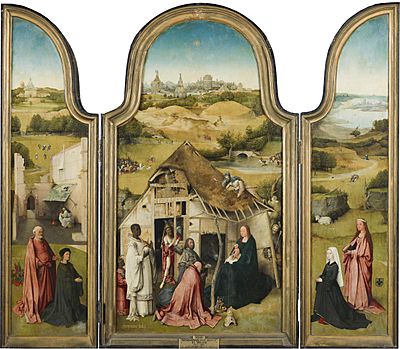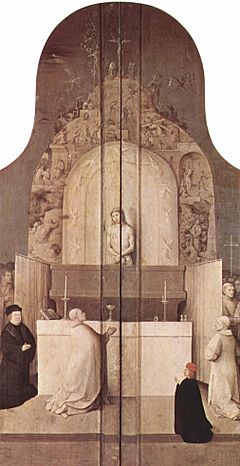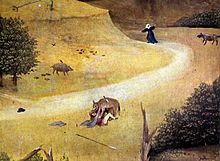Adoration of the Magi (Bosch, Madrid) facts for kids
Quick facts for kids Adoration of the Magi |
|
|---|---|
 |
|
| Artist | Hieronymus Bosch |
| Year | c. 1485-1500 |
| Medium | Oil on panel |
| Dimensions | 138 cm × 144 cm (54 in × 57 in) |
| Location | Museo del Prado, Madrid |
The Adoration of the Magi or The Epiphany is a triptych oil painting on wood panel by the Netherlandish artist Hieronymus Bosch, executed around 1485–1500. It is now in the Museo del Prado in Madrid, Spain.
History
In about 1494, Peeter Scheyfve (-1507) and Agnes de Gramme (?-about 1497) commissioned this altarpiece. They were wealthy burghers in Antwerp. The painting was in the El Escorial monastery, and was mentioned in 1605 as an "Epiphany without any extravaganza" by Fra Jose de Siguenza, and its being unlike Bosch's other work there. It has been at the Prado since 1839. The latest dendrochronological investigation (2016) has determined that the panels were produced after 1472 and most probably after 1474.
Description
Shutters
When closed, the triptych shutters showed externally a grisaille painting, depicting the Mass of Saint Gregory in a single scene: it features Gregory the Great kneeling at an altar in front of Christ. The latter is surrounded by an arch with flying angels. The two characters in color are a later addition, and are the painting's donors.
The frame contains scenes of the Life of Jesus: from the lower left, the Prayer in the Garden, The Arrest, Christ in Front of Pilatus, the Flagellation, the Coronation of Thorns, the Via Crucis and, finally, the Crucifixion. In the sky around the cross are a flying angel and a devil, with a red halo around his head, who is drawing Judas Iscariot's soul away. Judas is also visible hanging at the mountain's right edge, while a man is pointing at him.
Side panels
The left panel depict St. Peter and one donor, identified with Peeter Scheyfve thanks to the presence of his coat of arms, with the motto "Een voer al" ("One for all"). In the background, a man sits on a basket under a makeshift roofing: he is likely St. Joseph who heats Jesus' diapers.
In the right panel is St. Agnes and the eponymous donor, Agnes de Gramme, also accompanied by her coat of arms. In the background, a bear and a wolf attack some people.
Central panel
The central panel shows the Adoration of the Magi, depicted in accordance with traditional Early Netherlandish iconography. A monumental Mary sits outside a precarious hut, with the Child held at her womb. Melchior, the eldest of the Magi, is kneeling at her feet, with his gift before him: a sculpture of gold with the Sacrifice of Isaac, a forecast of Jesus' Passion. Below the object are several toads, symbols of heresy. Melchior's crown lies on the ground, an allusion to the powerlessness of earthly power against the celestial.
Caspar stands to the rear, with a depiction of the Visit of Queen Sheba to Solomon on his mantle. He brings frankincense on a vessel. Finally, the last of the Magi, the dark-skinned Balthazar, has white garments decorated by an embroidery resembling thorny leaves: brings a spherical pix whose reliefs depict the Offer of Water to King David, and which contains myrrh. Balthasar is accompanied by a dark-skinned servant.
An unusual element is represented by the partially naked figure at the hut's entrance, surrounded by other grotesque ones and characterized by a red mantle, a tiara with metallic twigs in the hand, and by a wheal at the left ankle, protected by a glass structure. This has been variously interpreted as either another prefiguration of the Passion, or as a symbol of the heresy looming the followers, or as the Judaic messiah which, after having been struck by leper, has become the Antichrist.
Other figures include the shepherds crawling the hut, a traditional element in Italian contemporary Adorations of the Magi; the armies running in the far background and the quasi-anthropomorphic constructions.
Painting materials
The pigments employed by the artist are consistent with his other works. He painted the triptych with ochres, lead-tin-yellow, vermilion, carmine and azurite. The sole rather unusual pigment is natural ultramarine used in small quantities in Virgin's robe.
See also
- List of paintings by Hieronymus Bosch
- Adoration of the Magi (Bosch, New York)
- Adoration of the Magi (Bosch, Philadelphia)




